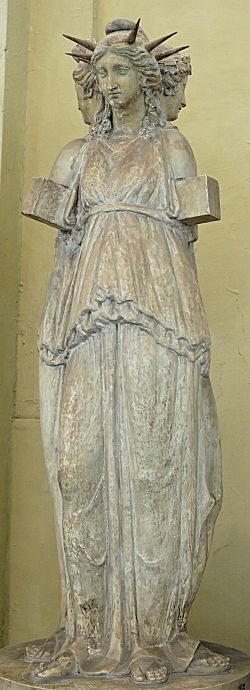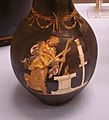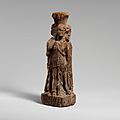Hecate facts for kids
Quick facts for kids Hecate |
|
|---|---|
| Goddess of boundaries, transitions, crossroads, magic, the New Moon, necromancy, and ghosts. | |

The Hecate Chiaramonti, a Roman sculpture of triple-bodied Hecate, after a Hellenistic original (Museo Chiaramonti, Vatican Museums)
|
|
| Abode | Underworld |
| Animals | Dog, polecat |
| Symbol | Paired torches, dogs, serpents, keys, daggers, and Hecate's wheel is known as a stropholos. |
| Offspring | Aegialeus, Circe, Empusa, Medea, Scylla |
| Parents | Perses and Asteria |
| Equivalents | |
| Mesopotamian equivalent | Ereshkigal (used as an epithet in a late Greek magical text) |
| Slavic equivalent | Marzanna |
Hecate (Greek: Ἑκάτη, Hekátē) is the goddess of magic, crossroads, witchcraft, sorcery, ghosts and necromancy in ancient Greek religion and myth. She was one of several deities worshipped in ancient Athens as a protector of the oikos (household), alongside Zeus, Hestia, Hermes, and Apollo.
The daughter of Perses and Asteria (twin sister of Leto), Hecate was a member of the third generation of Titans, but sided with Zeus and his siblings during the Titanomachy. As such, she was greatly honored by Zeus, who allowed her to operate on Earth, as well as the sky and the Underworld. A nocturnal figure, Hecate often dwelled in underground caves or in the Underworld itself.
The Romans knew her by the epithet of Trivia, an epithet she shares with Diana/Artemis, each in their roles as protector of travel and of the crossroads (trivia, "three ways").
Contents
Iconography
Hecate was generally represented as three-formed or triple-bodied, though the earliest known images of the goddess are singular. In later times, Hecate was depicted as a woman with three-heads, thought to represent the past, present and future. Her symbols were a pair of torches, keys and daggers. The serpent, polecat, and dog were considered her sacred animals.
In her three-headed representations, Hecate often has one or more animal heads, including cow, dog, boar, serpent, and horse.
Sacred plants
Hecate was closely associated with plant lore and the concoction of medicines and poisons. She was said to favour offerings of garlic. She is also sometimes associated with cypress, a tree representing death and the underworld.
Functions
Hecate was often invoked as a household deity, to provide aid in warding off evil spirits. She was associated with borders (city walls, doorways, crossroads) and, by extension, with realms outside or beyond the world of the living. She was seen as guardian of entrances. In Byzantium she was a deity of protection. When Philip of Macedon was about to attack the city, according to the legend she alerted the townspeople with her ever present torches, and with her pack of dogs, which served as her constant companions.
Hecate is also recognized as an underworld goddess. She is the holder of the keys that can unlock the gates of death. She takes on the role of guardian not just of roads, but of all journeys, including the journey to the afterlife.
Hecate assisted Demeter in her search for her daughter Persephone following Hades' abduction of her, guiding the goddess' path at night by her flaming torches. Afterwards, she frequently served as a companion of Persephone, joining her on her yearly journey to and from the realm of the dead.
Often identified with the goddesses Artemis and Selene, Hecate served as a representative of the harvest moon.
By the 1st century CE, Hecate was heavily associated with witchcraft, witches, magic, and sorcery.
Cult
Hecate was a popular divinity, and her cult was practiced all over Greece and Western Anatolia. Caria was a major center of worship. Her most famous temple was located in the town of Lagina. Aside from her own temples, Hecate was also worshipped in the sanctuaries of other gods.
Cult images and altars of Hecate were placed at three-way crossroads, doorways to homes, temples, and cities with the belief that it would protect from restless dead and other spirits.
Parents, consorts and children
In the earliest written source mentioning Hecate, she was an only child, the daughter of Perses and Asteria, the sister of Leto (the mother of Artemis and Apollo). In various later accounts, Hecate was given different parents.
Hecate remained unmarried and had no regular consort.
See also
 In Spanish: Hécate para niños
In Spanish: Hécate para niños
Images for kids
-
Hekataion with the Charites, Attic, 3rd century BCE (Glyptothek, Munich)
-
A goddess, probably Hecate (possibly Artemis), is depicted with a bow, dog and twin torches.
-
Hecate holding two torches and dancing in front of an altar, beyond which is a cult statue, ca. 350–300 BC, red-figure vase, Capua, Italy.
-
Hecate, Greek goddess of the crossroads; drawing by Stéphane Mallarmé in Les Dieux Antiques, nouvelle mythologie illustrée in Paris, 1880
-
The coins of Agathocles of Bactria (ruled 190–180 BCE), show Zeus holding Hecate in his hand.
-
Hecate battles Clytius next to Artemis, Gigantomachy frieze, Pergamon Altar, Pergamon Museum, Berlin.












